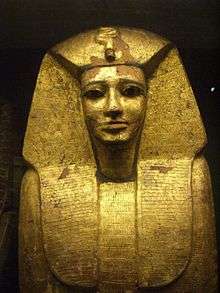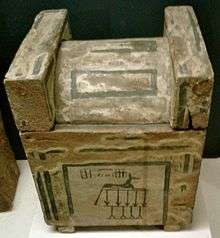Sekhemre-Wepmaat Intef
| Sekhemre-Wepmaat Intef | ||||||||||||||||||||||||||||||||||||||||||||||||||||||||||||||||||
|---|---|---|---|---|---|---|---|---|---|---|---|---|---|---|---|---|---|---|---|---|---|---|---|---|---|---|---|---|---|---|---|---|---|---|---|---|---|---|---|---|---|---|---|---|---|---|---|---|---|---|---|---|---|---|---|---|---|---|---|---|---|---|---|---|---|---|
 Sarcophagus of Sekhemre-Wepmaat Intef, Louvre Museum | ||||||||||||||||||||||||||||||||||||||||||||||||||||||||||||||||||
| Pharaoh | ||||||||||||||||||||||||||||||||||||||||||||||||||||||||||||||||||
| Reign | c.1573?-1571 BC[1] (17th Dynasty of Egypt) | |||||||||||||||||||||||||||||||||||||||||||||||||||||||||||||||||
| Predecessor | Sobekemsaf II | |||||||||||||||||||||||||||||||||||||||||||||||||||||||||||||||||
| Successor | Nubkheperre Intef | |||||||||||||||||||||||||||||||||||||||||||||||||||||||||||||||||
| ||||||||||||||||||||||||||||||||||||||||||||||||||||||||||||||||||
| Father | Sobekemsaf II | |||||||||||||||||||||||||||||||||||||||||||||||||||||||||||||||||
Sekhemre-Wepmaat Intef (or Antef, Inyotef) was an Egyptian king of the Seventeenth Dynasty of Egypt, who lived late during the Second Intermediate Period, when Egypt was divided into two by Hyksos controlled Lower Egypt and Theban ruled Upper Egypt.
Sekhemre-Wepmaat Intef is sometimes referred to as Intef V,[2][3] and sometimes as Intef VI.[4] His nomen, Intef-aa, translates as "His father brought him, the great" or "Intef, the great."[5]
He ruled from Thebes, and was probably buried in a tomb in the necropolis. His rishi coffin, Louvre E 3019, was discovered in the 19th century and found to preserve an inscription which reveals that this king's brother Nubkheperre Intef buried – and thus succeeded – him.[6]

Both Sekhemre-Wepmaat Intef and Nubkheperre Intef were sons of a king called Sobekemsaf, most probably Sekhemre Shedtawy Sobekemsaf (Sobekemsaf II today, not I) based on an inscription from a doorjamb from a 17th Dynasty temple at Gebel Antef.[7] While his own tomb has not been located, it was likely located in the area of Dra' Abu el-Naga' where the pyramid tomb of his brother Nubkheperre Intef was found in 2001.[8] The pyramidion of the pyramid of Sekhemre-Wepmaat Intef's pyramid was found in Dra' Abu el-Naga'. It has a slope of 60 degrees and is inscribed with this king's names.[2] The pyramidion is now in the British Museum (BM EA 478).[9]
References
- ↑ Kim Ryholt, The Political Situation in Egypt during the Second Intermediate Period, CNI Publications, Copenhagen: Museum Tusculanum Press, 1997, p.204
- 1 2 Lehner, Mark. The Complete Pyramids. Thames & Hudson. 2008 (reprint). ISBN 978-0-500-28547-3
- ↑ Dodson, Aidan and Hilton, Dyan. The Complete Royal Families of Ancient Egypt. Thames & Hudson. 2004. ISBN 0-500-05128-3
- ↑ Chris Bennett, A Genealogical Chronology of the Seventeenth Dynasty, Journal of the American Research Center in Egypt, Vol. 39 (2002), pp. 123-155 JSTOR (Bennett quotes Beckerath as also referring to this king as Intef VI.)
- ↑ Intef Wepmaat Titulary
- ↑ Kim Ryholt, The Political Situation in Egypt during the Second Intermediate Period, CNI Publications, Copenhagen: Museum Tusculanum Press, 1997, p.270
- ↑ Ryholt, p.270
- ↑ Thomas Schneider, "The Relative Chronology of the Middle Kingdom and the Hyksos Period (Dyns. 12-17)" in Erik Hornung, Rolf Krauss & David Warburton (editors), Ancient Egyptian Chronology (Handbook of Oriental Studies), Brill, 2006. p.187
- ↑ Dodson, Aidan. The Tomb in Ancient Egypt. Thames and Hudson. 2008. p 208, ISBN 9780500051399
| Preceded by Sobekemsaf II |
Pharaoh of Egypt Seventeenth Dynasty |
Succeeded by Nubkheperre Intef |
Online Resource
- Sekhemre Wepmaat's titulary
